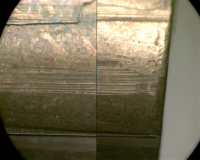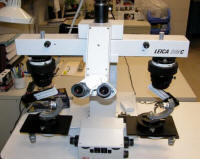|
Firearms
Forensic scientists
conduct various types of firearms examinations such as function checks,
restoring obliterated serial numbers, determining a type of gun that may
have fired a particular bullet or cartridge case, effecting firearms
identifications and determining muzzle-to-target distance.
 |
|
Bullet
comparison |
Much like the spiral
a quarterback puts on a football, a bullet must spin as it leaves the
barrel of a gun to prevent it from toppling end-over-end allowing for a
straight and accurate trajectory. To force a bullet to spin, gun
manufacturers use lands and grooves, or rifling, inside gun barrels.
The lands are raised ridges that twist down the length of the barrel, so
when the bullet comes in contact with the raised ridges the lands force
the bullet to spin. The manufacturing process used to produce lands and
grooves results in unique microscopic imperfections that ”scratch” the
surface of a bullet as it travels through the barrel. These scratches,
called striations, form a unique pattern and are the basis for firearms
identification.
A
cartridge case, the ammunition component that initially holds the gun
powder, can also pick-up markings
from the inner workings of a firearm.
Newton’s third law of motion states “that for every action, there is an
equal and opposite reaction.” When
a gun is fired, the “explosion”
forces the bullet forward and the cartridge case rearward. As the
cartridge case travels rearward through the gun and comes in contact
with numerous surfaces, it is marked by the microscopic imperfections
present on those
surfaces. As with striations on bullets, these
markings are used for identification purposes.
A
firearm submitted to the laboratory will be test fired multiple times
into a recovery tank. This recovery tank, filled with approximately 200
gallons of water, provides a safe and effective method of retrieving
bullets from a fired gun. The water stops a fired bullet without
damaging the bullet so it may be used for microscopical comparison.
 |
|
Comparison
microscope |
Comparisons
of suspect and evidence samples are conducted using a comparison
microscope which is actually two microscopes joined by one optical
bridge. This allows scientists to examine two objects at the same time
within the same field of view. A firearms examiner uses fired
standards, bullets and cartridge cases from a gun fired in the
laboratory, to compare to fired evidence collected from the crime
scene. Standards produced in the laboratory are first compared to each
other to determine if the gun is producing individual characteristics in
a unique and consistent pattern. Once a consistently reoccurring
pattern is identified on the standards, the standards can then be
compared to the evidence to see if the same pattern of marks exists.
Standards collected
from guns fired in the laboratory are not only compared to fired
evidence from crime scenes, but are also compared to our Unsolved Case
File. The Gun Recovery and Identification Program, also known as GRIP,
consists of a collection of fired evidence samples that are associated
with unsolved shootings in DuPage County. Under GRIP, standards
collected from guns submitted to the laboratory are screened against a
digitized and catalogued unsolved case file.
|